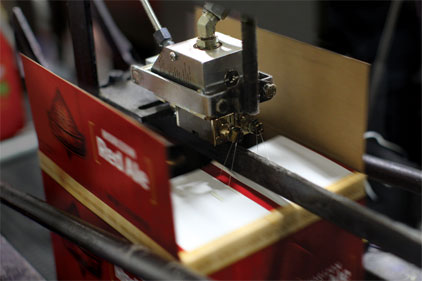
|
| The InvisiPac™ applicator modules dispense adhesive to Summit Brewery Company’s cartons. |
Summit Brewing Company in St. Paul, MN used to use a traditional hot-melt adhesive tank system to seal its beer cartons, which was prone to charring, plugs and material degradation. These problems led to production downtime, required constant equipment maintenance and increased costs. A Summit manager often used a blowtorch on his hot melt guns to clear tip plugs and limit line delays.
The brewery’s old style hot-melt tank unit required an entire tank of adhesive to be melted before the line could start up. Because of its 45-minute startup time, the glue tank would have to remain heated even when adhesive was not needed. The longer the adhesive was heated, the more likely it charred and clogged the nozzles.
Minneapolis-based Graco (www.graco.com) offered its InvisiPac™ Tank-Free™ Hot Melt Delivery System and GS35 Plug-Free Hot Melt Applicator as a solution. The system is designed to seal cartons more efficiently with a startup time of 10 minutes or less. Summit installed two of the two-channel InvisiPac systems last spring, and will be installing two more this year. The blowtorch will no longer be needed.
The delivery system
The vacuum pulls adhesive pellets from a vibrating 30-gallon drum. It has a sensor that monitors the adhesive levels and automatically draws pellets at the required amounts. It draws them fast enough to accommodate a continuous throughput of 25 pounds of adhesive per hour. The use of a vacuum feed keeps the system relatively closed, limiting ingression points for dust and debris.
From the vacuum, the adhesive pellets are transferred to the InvisiPac Hot-Melt Delivery System, where the pellets are heated in an in-line melt chamber. The chamber can reach the standard 350-degree operating level in 10 minutes.
The in-line melt chamber
Rather than heating liters of adhesive at one time an in-line melting chamber heats only 0.7 liters of adhesive at a time. The decreased heating time and adhesive volume leads to less charring and plugging in the applicator nozzles.
Once the adhesive is melted in the chamber, it is transferred directly to the pump, which uses a two-ball design that has worked with other applicators. In two strokes, the pump cycles only five grams of adhesive, but it cycles fast enough to reach the high throughput.
These elements allow the adhesive to flow freely, from pellets to melted glue, in an automated system that can fulfill the continuous throughput rate of 25 pounds of adhesive per hour.
The controls and results
As with the pump and applicators, Graco integrated a control interface that has worked with a variety of pumps and spray equipment. The Advanced Display Module uses graphics and text to simplify operations and troubleshooting. It tracks and clearly displays adhesive levels, the components’ temperature and operations, as well as detailed usage information, event history, errors and other logs that are downloadable through a USB port.
“We’re installing a couple more,” says Kenny Gunderman, Summit’s packaging manager. “When it works—why not?”

